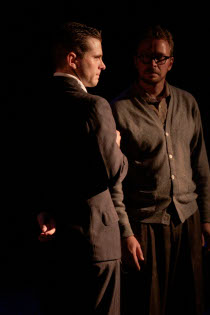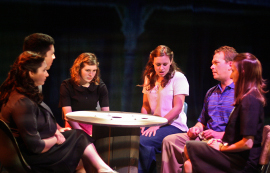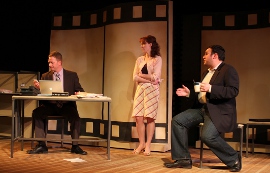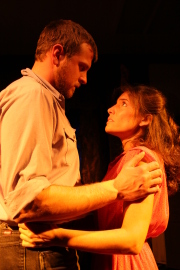 Jeremy Mahr seems to be dancing with his dialogue as Willmore, the titular character in the Prenzie Players' The Rover. Author Aphra Behn's words trip the light fantastic off his tongue, with Mahr presenting his rakish playboy so playfully that it's as though he's fluent in the stylized, 17th Century language of the period. And when the meaning of what he's saying is expressed through his entire body - particularly during Willmore's more amorous lines - the obviously fully invested Mahr is incredibly fun to watch.
Jeremy Mahr seems to be dancing with his dialogue as Willmore, the titular character in the Prenzie Players' The Rover. Author Aphra Behn's words trip the light fantastic off his tongue, with Mahr presenting his rakish playboy so playfully that it's as though he's fluent in the stylized, 17th Century language of the period. And when the meaning of what he's saying is expressed through his entire body - particularly during Willmore's more amorous lines - the obviously fully invested Mahr is incredibly fun to watch.

 I went into Red, playwright John Logan's drama about abstract expressionist Mark Rothko and his young assistant Ken, with uncertainty about how to appreciate visual art beyond just liking pretty things I see. I left Friday's QC Theatre Workshop production with a better understanding of meaning and intent in art, while also feeling a disdain for abstract expressionism, particularly Mark Rothko's "color fields." And while I'm not certain that Logan's intent is for viewers to dislike Rothko or his paintings, I do think he wants audiences to walk away with emotion and opinions about the artist's creations - making my distaste for Rothko evidence that Logan's work is effective.
I went into Red, playwright John Logan's drama about abstract expressionist Mark Rothko and his young assistant Ken, with uncertainty about how to appreciate visual art beyond just liking pretty things I see. I left Friday's QC Theatre Workshop production with a better understanding of meaning and intent in art, while also feeling a disdain for abstract expressionism, particularly Mark Rothko's "color fields." And while I'm not certain that Logan's intent is for viewers to dislike Rothko or his paintings, I do think he wants audiences to walk away with emotion and opinions about the artist's creations - making my distaste for Rothko evidence that Logan's work is effective.
 Augustana College's How I Learned to Drive offers an interesting opportunity to compare the acting talents of performers at different points in their lives, as there's a marked contrast between Reader editor Mike Schulz's work and that of the students who compose the rest of the cast. Being beyond college-age (and hired here as a guest actor), Schulz is presumably more aware of the darkness in the world, the pain of real life, and the reality of what some would call sin. I imagine he's subsequently able to draw from what he knows and use it to shape his character, whereas it's apparent that the students are feigning their feelings. To be clear, that's not to say that the students are poor actors, and each one offered a notable performance during Friday's presentation. Compared to Schulz's effort, however, there are distinct differences in the sincerity of their portrayals.
Augustana College's How I Learned to Drive offers an interesting opportunity to compare the acting talents of performers at different points in their lives, as there's a marked contrast between Reader editor Mike Schulz's work and that of the students who compose the rest of the cast. Being beyond college-age (and hired here as a guest actor), Schulz is presumably more aware of the darkness in the world, the pain of real life, and the reality of what some would call sin. I imagine he's subsequently able to draw from what he knows and use it to shape his character, whereas it's apparent that the students are feigning their feelings. To be clear, that's not to say that the students are poor actors, and each one offered a notable performance during Friday's presentation. Compared to Schulz's effort, however, there are distinct differences in the sincerity of their portrayals.
 I quite appreciate the way Kimberly Furness and Eddie Staver III work with tension, using silence, emotional distance, anger, and passionate desire, among other acting tools, to portray the intensity (or lack thereof) in their onstage relationships. Their violent, sometimes stunted, oftentimes broken, yet undeniably sensual connection in both the Curtainbox Theatre Company's Danny & the Deep Blue Sea in 2008 and Fool for Love in 2010 was breathtaking to watch. And while their current efforts in Time Stands Still are much more subtle, they're no less dramatic. Instead of their stunning physical work in the previous two shows, Furness' and Staver's performances here rely on the verbal and emotional aspects of their relationship, one superbly crafted by these gifted actors.
I quite appreciate the way Kimberly Furness and Eddie Staver III work with tension, using silence, emotional distance, anger, and passionate desire, among other acting tools, to portray the intensity (or lack thereof) in their onstage relationships. Their violent, sometimes stunted, oftentimes broken, yet undeniably sensual connection in both the Curtainbox Theatre Company's Danny & the Deep Blue Sea in 2008 and Fool for Love in 2010 was breathtaking to watch. And while their current efforts in Time Stands Still are much more subtle, they're no less dramatic. Instead of their stunning physical work in the previous two shows, Furness' and Staver's performances here rely on the verbal and emotional aspects of their relationship, one superbly crafted by these gifted actors.
 Erin Churchill is the reason to see the Curtainbox Theatre Company's current production, Speed-the-Plow. Actually, that's a bit deceptive, as it implies that she's the only reason to see the show. Curtainbox founder Kimberly Furness' directorial debut with her company is applause-worthy, as are the stellar performances of the play's other cast members, Mike Schulz (a Reader employee) and Daniel M. Hernandez. However, it was Churchill's sincerity, earnestness, and diversity that closed the deal for me, leaving me in utter awe during Saturday night's performance.
Erin Churchill is the reason to see the Curtainbox Theatre Company's current production, Speed-the-Plow. Actually, that's a bit deceptive, as it implies that she's the only reason to see the show. Curtainbox founder Kimberly Furness' directorial debut with her company is applause-worthy, as are the stellar performances of the play's other cast members, Mike Schulz (a Reader employee) and Daniel M. Hernandez. However, it was Churchill's sincerity, earnestness, and diversity that closed the deal for me, leaving me in utter awe during Saturday night's performance.
 [Author's note: The following was written for
[Author's note: The following was written for  I distinctly remember, in 1998, watching a PBS documentary prior to the 52nd Tony Awards ceremony, one in which I was enraptured by a segment featuring a nominated play. Captivating me with its quick-paced, witty, and sharp-tongued dialogue, the play was author Yasmina Reza's Art, and the clip featured the original Broadway cast of Alan Alda, Victor Garber, and Alfred Molina, making my desire to see it all the deeper. The show's premise, though, seemed almost stupid, involving the purchase of a white painting for $200,000. "How could anyone create a play around that concept," I thought, "and make it remotely interesting?"
I distinctly remember, in 1998, watching a PBS documentary prior to the 52nd Tony Awards ceremony, one in which I was enraptured by a segment featuring a nominated play. Captivating me with its quick-paced, witty, and sharp-tongued dialogue, the play was author Yasmina Reza's Art, and the clip featured the original Broadway cast of Alan Alda, Victor Garber, and Alfred Molina, making my desire to see it all the deeper. The show's premise, though, seemed almost stupid, involving the purchase of a white painting for $200,000. "How could anyone create a play around that concept," I thought, "and make it remotely interesting?" The more performances I see as a reviewer, the more I ponder and study stagecraft. With many productions, I take away a concept or idea as to what makes a performance good, whether at the individual level or for an entire production. With the Curtainbox Theatre Company's Fool for Love, it's a word: abandon.
The more performances I see as a reviewer, the more I ponder and study stagecraft. With many productions, I take away a concept or idea as to what makes a performance good, whether at the individual level or for an entire production. With the Curtainbox Theatre Company's Fool for Love, it's a word: abandon.







